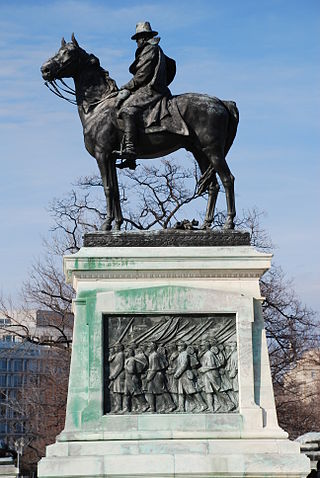
The Ulysses S. Grant Memorial is a presidential memorial in Washington, D.C., honoring American Civil War general and 18th United States President Ulysses S. Grant. It sits at the base of Capitol Hill, below the west front of the United States Capitol. Its central sculpture of Grant on horseback faces west, overlooking the Capitol Reflecting Pool and facing toward the Lincoln Memorial, which honors Grant's wartime president, Abraham Lincoln. Grant's statue is raised on a pedestal decorated with bronze reliefs of the infantry; flanking pedestals hold statues of protective lions and bronze representations of the Union cavalry and artillery. The whole is connected with marble covered platforms, balustrades, and stairs. The Grant and Lincoln memorials define the eastern and western ends, respectively, of the National Mall.

Captain María Inés Ortiz was the first American nurse to die in combat during Operation Iraqi Freedom and the first U.S. Army nurse to die in combat since the Vietnam War. The United States Army named the Forward Operating Base Prosperity clinic after her.

General Philip Sheridan is a bronze sculpture that honors Civil War general Philip Sheridan. The monument was sculpted by Gutzon Borglum, best known for his design of Mount Rushmore. Dedicated in 1908, dignitaries in attendance at the unveiling ceremony included President Theodore Roosevelt, members of the President's cabinet, high-ranking military officers and veterans from the Civil War and Spanish–American War. The equestrian statue is located in the center of Sheridan Circle in the Sheridan-Kalorama neighborhood of Washington, D.C. The bronze statue, surrounded by a plaza and park, is one of eighteen Civil War monuments in Washington, D.C., which were collectively listed on the National Register of Historic Places in 1978. The sculpture and surrounding park are owned and maintained by the National Park Service, a federal agency of the Interior Department.
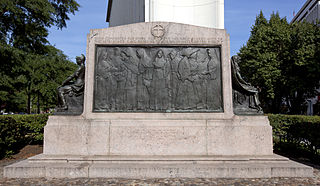
Nuns of the Battlefield is a public artwork made in 1924 by Irish artist Jerome Connor, located at the intersection of Rhode Island Avenue NW, M Street, and Connecticut Avenue NW, in Washington, D.C., United States. A tribute to the more than 600 nuns who nursed soldiers of both armies during the American Civil War, it is one of two monuments in the District that mark women's roles in the conflict. It is a contributing monument to the Civil War Monuments in Washington, D.C., listed on the National Register of Historic Places. In 1993, it was surveyed for the Smithsonian Institution's Save Outdoor Sculpture! program.

A statue of Abraham Lincoln by American artist Gaetano Cecere is installed along Lincoln Memorial Drive in Milwaukee, Wisconsin, United States. The 10'6" bronze sculpture depicts a young beardless Abraham Lincoln. The former president stands looking down with both hands at his sides.

Major General George Henry Thomas, also known as the Thomas Circle Monument, is an equestrian sculpture in Washington, D.C. that honors Civil War general George Henry Thomas. The monument is located in the center of Thomas Circle, on the border of the downtown and Logan Circle neighborhoods. It was sculpted by John Quincy Adams Ward, best known for his work on the statue of George Washington in Wall Street, Manhattan. Attendees at the dedication in 1879 included President Rutherford B. Hayes, Generals Irvin McDowell, Philip Sheridan, and William Tecumseh Sherman, senators and thousands of soldiers.
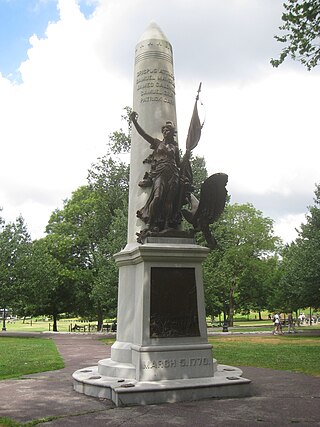
The Boston Massacre Monument, also known as the Crispus Attucks Monument and Victory, is an outdoor bronze memorial by Adolph Robert Kraus, installed in Boston Common, in Boston, Massachusetts, United States.

An equestrian statue of Joseph Hooker is installed outside the Massachusetts State House, facing Beacon Street in Boston, in the United States.

The George Robert White Memorial, also known as The Spirit of Giving, is an outdoor memorial commemorating George Robert White by artist Daniel Chester French and architect Henry Bacon, installed in Boston's Public Garden, in the U.S. state of Massachusetts. The 1924 bronze sculpture depicts an allegorical winged female on a Rockport granite base, above an elliptical-shaped granite and pebble fountain. It was surveyed as part of the Smithsonian Institution's "Save Outdoor Sculpture!" program in 1993.

A statue of Daniel Webster by Hiram Powers is installed outside the Massachusetts State House, in Boston, Massachusetts, United States.

A statue of Tadeusz Kościuszko by Theo Alice Ruggles Kitson is installed in Boston's Public Garden, in the U.S. state of Massachusetts.
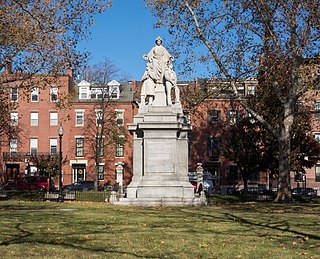
The Charlestown Civil War Memorial, also known as the Soldiers' and Sailors' Monument, is an outdoor granite monument and sculpture by Martin Milmore, commemorating the men of Charlestown, Boston, who fought to preserve the Union during the American Civil War. The memorial is installed in the Training Field in Charlestown, in the U.S. state of Massachusetts.

The World War II Memorial by John Francis Paramino is installed in Boston, Massachusetts, United States. It was completed during 1947–1949, copyrighted in 1948, and erected in 1949. The bronze and granite war memorial features an allegorical statue of winged female figure of Victory. Behind her is a wall with 27 bronze plaques listing the names of people who died in World War II. The work was surveyed as part of the Smithsonian Institution's "Save Outdoor Sculpture!" program in 1993.
The Arthur Fiedler Memorial by Ralph Helmick is installed along the Charles River Esplanade, in Boston, Massachusetts, United States.
The Marvin E. Goody Memorial by Joan Goody is installed in Boston's Public Garden, in the U.S. state of Massachusetts. The red granite and Dakota mahogany memorial was dedicated in 1984, having been funded by Friends of the Public Garden and Common. It was surveyed as part of the Smithsonian Institution's "Save Outdoor Sculpture!" program in 1993.

A 1953 statue of George S. Patton by James Earle Fraser is installed along Boston's Charles River Esplanade, in the U.S. state of Massachusetts.

A statue of David I. Walsh by Joseph Coletti is installed along Boston's Charles River Esplanade, in the U.S. state of Massachusetts.
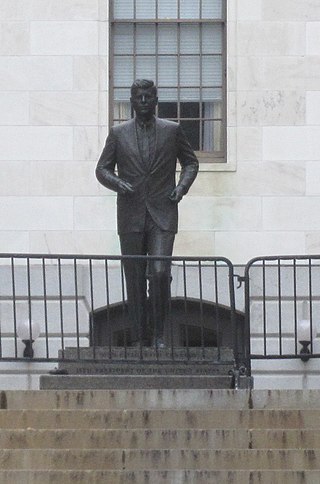
A statue of John F. Kennedy by Isabel McIlvain is installed outside the Massachusetts State House in Boston, Massachusetts, United States.

Boston Public Garden Flagpole Base is a 1921 flagpole base, memorial, and sculpture by William D. Austen, installed in Boston Public Garden, in Boston, Massachusetts, United States. The bronze base measures approximately 6 x 4 x 4 ft., and rests on a granite plinth that measures 3.5 x 7 x 7 ft. It has four facades with reliefs depicting American eagles holding branches and spreading their wings, and serves as a World War I memorial. The base replaced another destroyed by lightning in 1920. It was originally installed at the site of the original base, at the intersection of Boylston Street and Arlington Street, but was relocated to its present location in 1933. The work was surveyed by the Smithsonian Institution's "Save Outdoor Sculpture!" program in 1993.

A statue of William Francis Bartlett stands inside the Massachusetts State House in Boston, Massachusetts, United States. The bronze statue was designed by sculptor Daniel Chester French and honors Bartlett, who had served as a general in the Union Army during the American Civil War. The statue was dedicated in 1904.


















